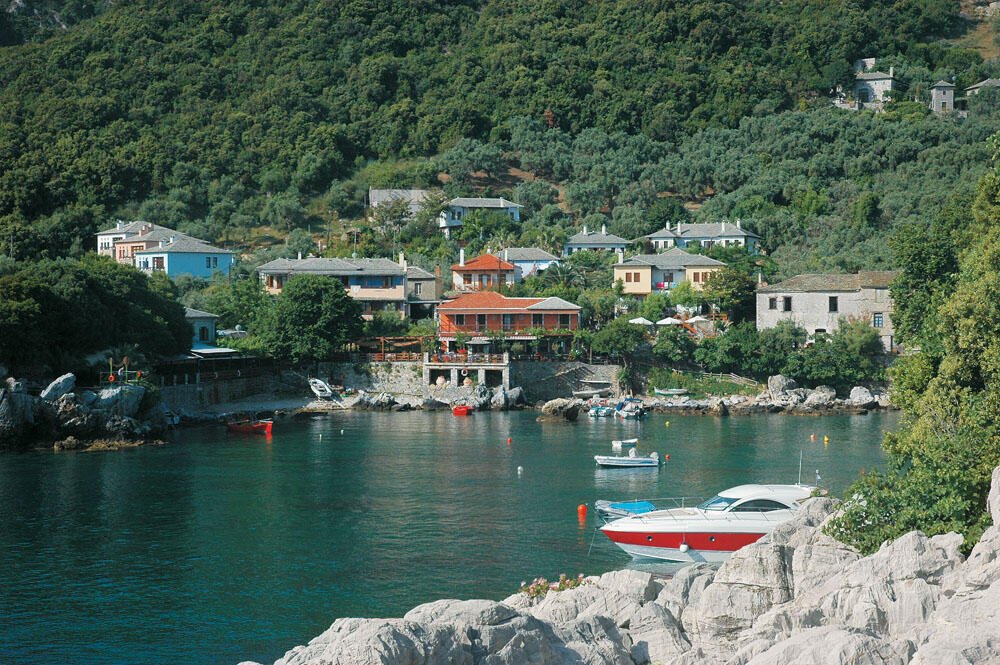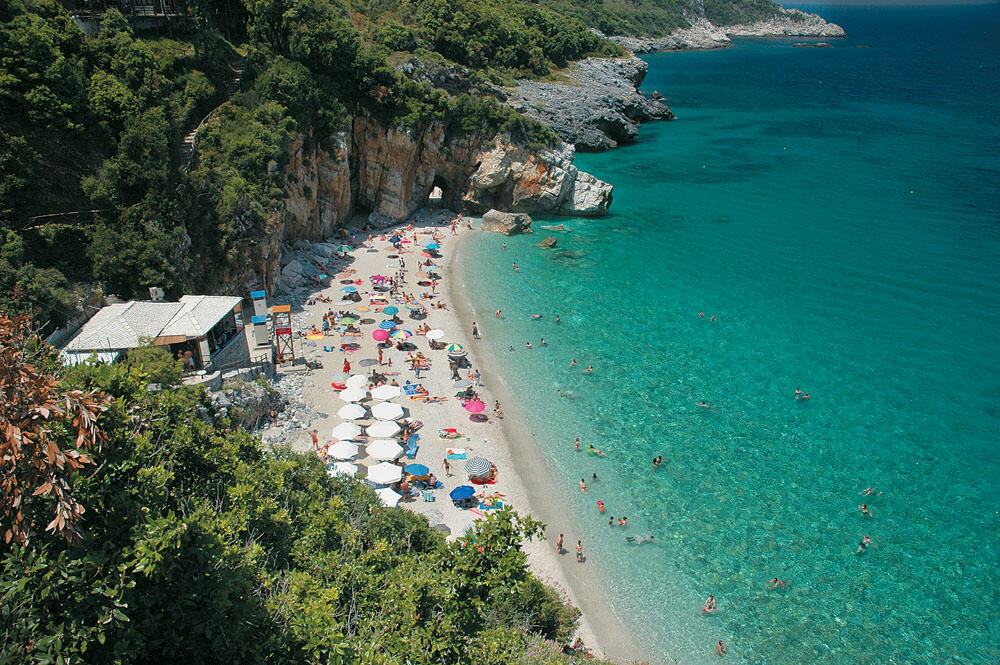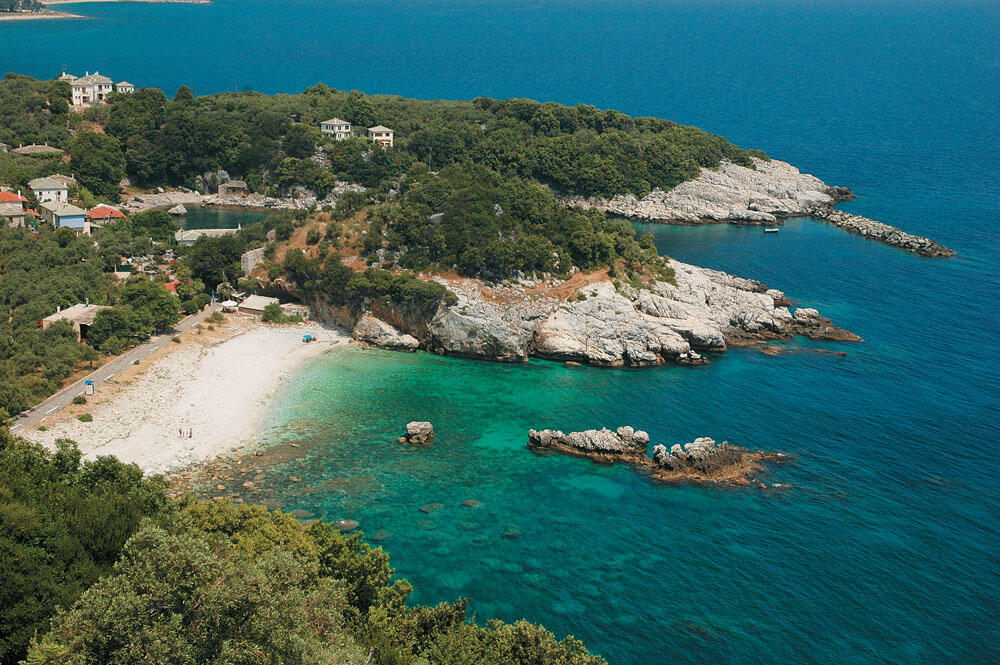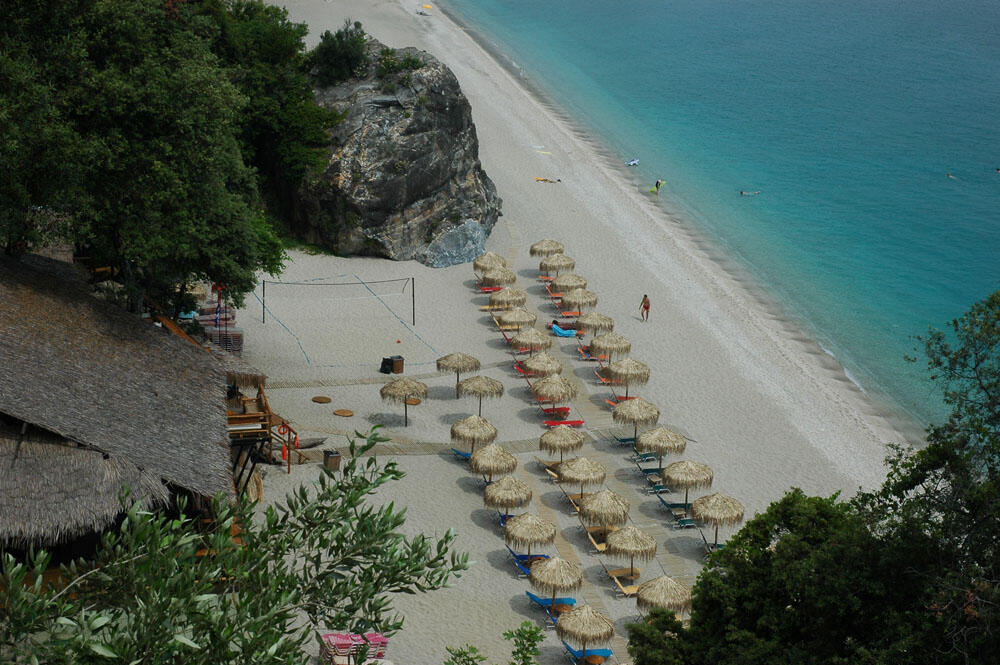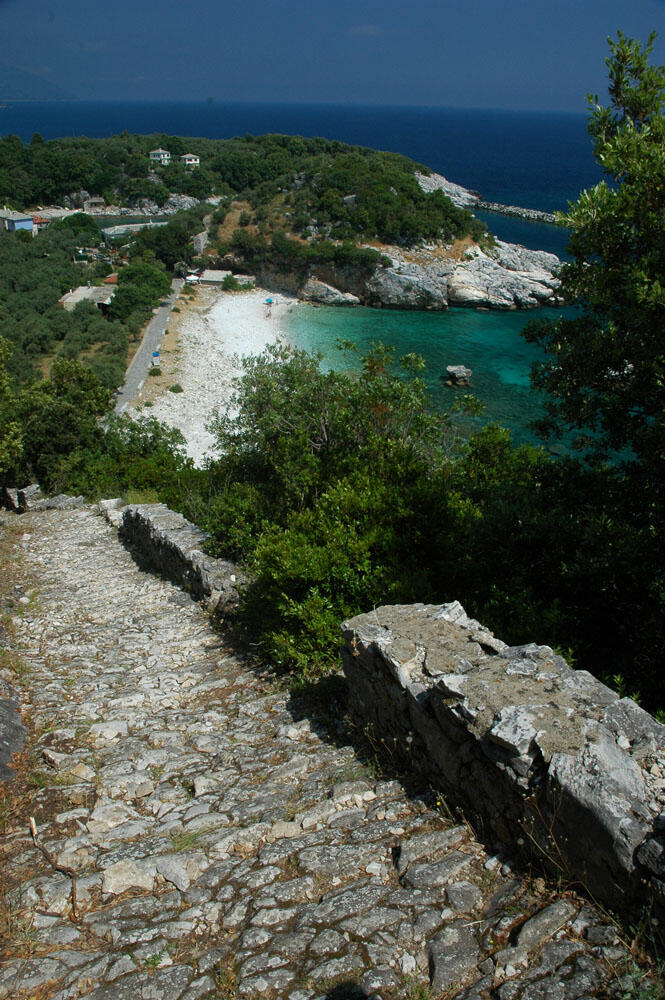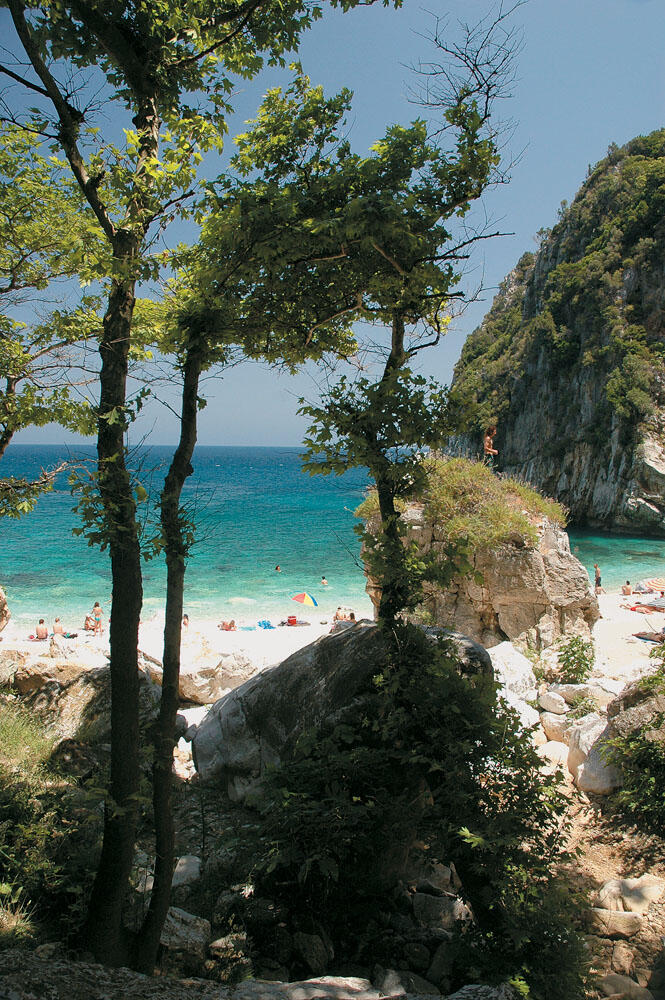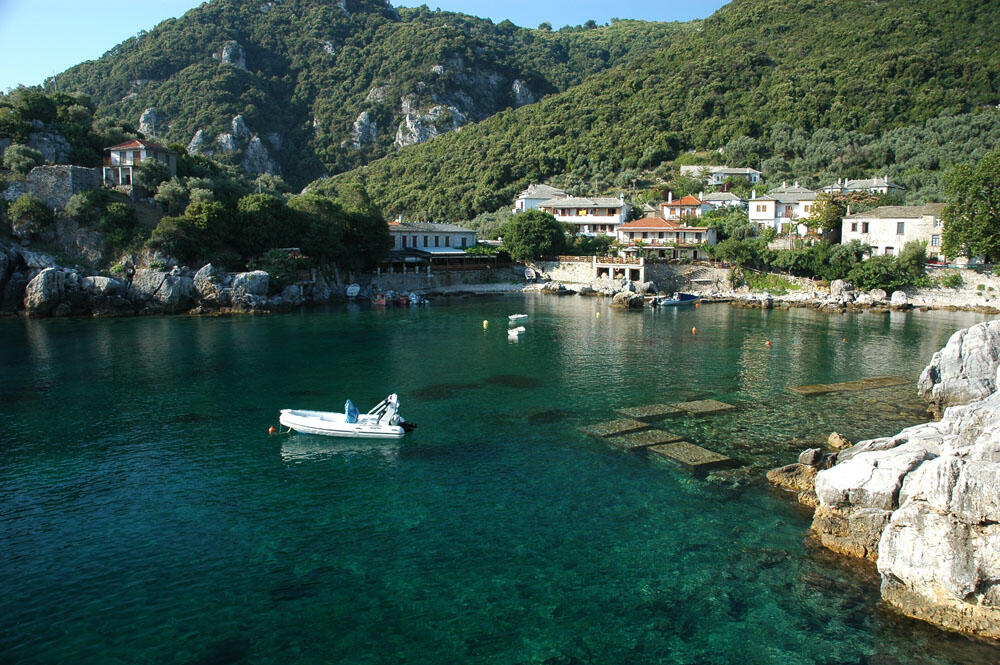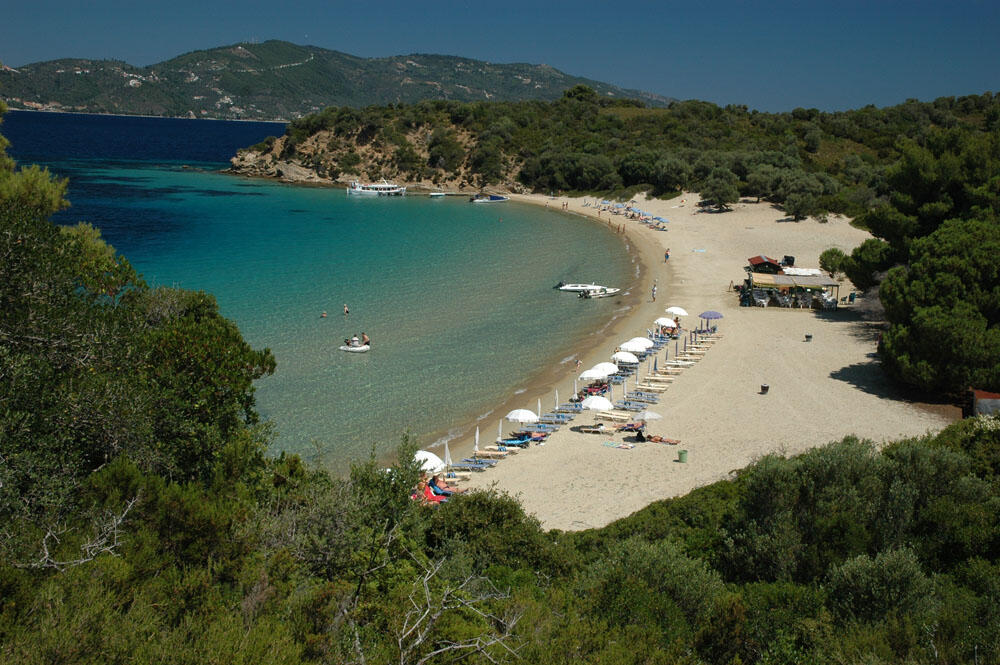
Skiathos Island
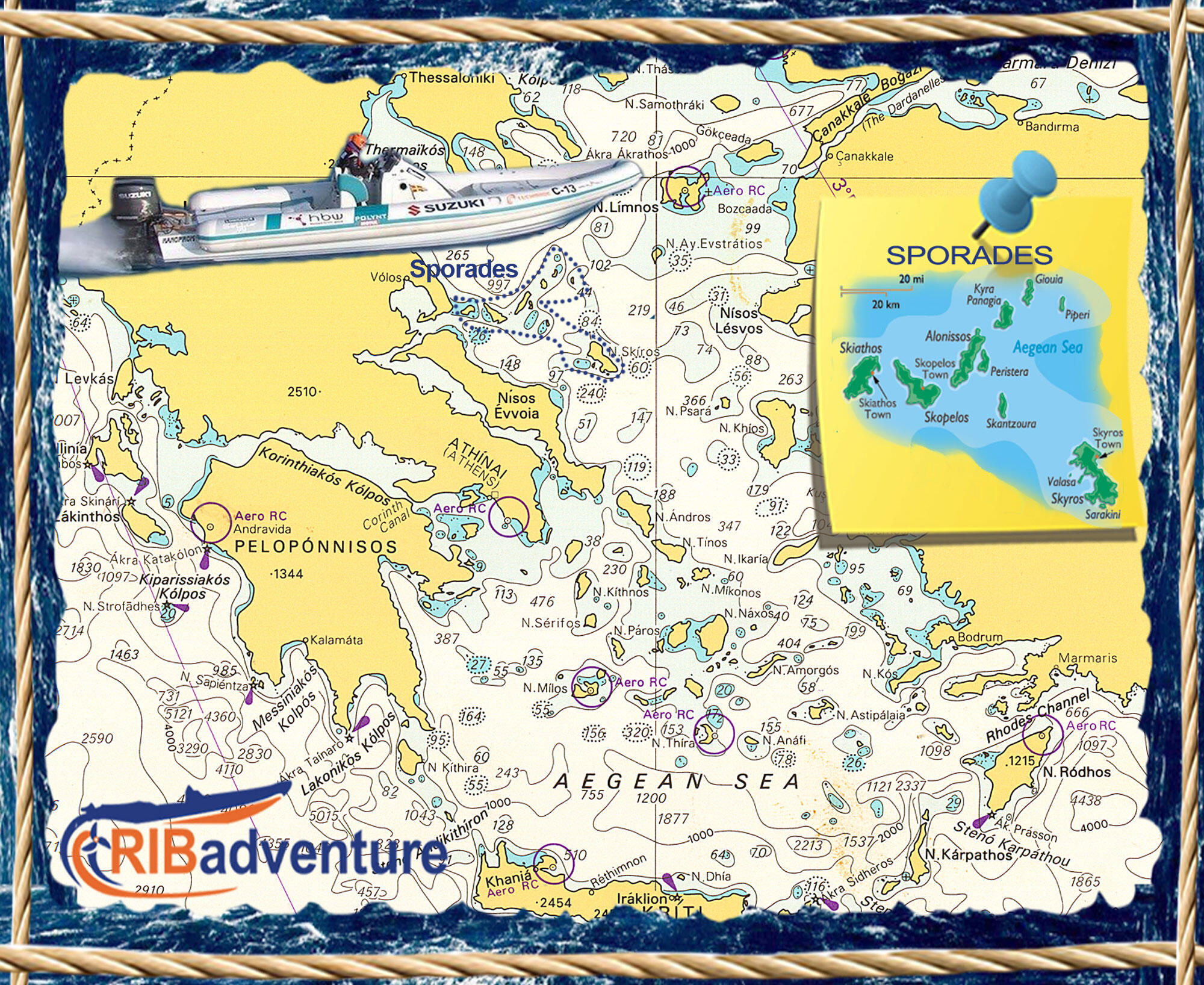
Sporades islands

Skiathos Island

Sporades islands
Traveling to Eastern Pelion
.. that absolute feeling of freedom
and that admirable solitude in the ocean
when the winds rage or when the sea is drugged.
Hours of calm and many times of happiness
alternating with moments of fear and anxiety, in a passionate affair...
Four people, crammed into the small jeep that struggled up every hill dragging the overweight inflatable behind it. It was ten o'clock in the evening and we were traveling at low speed on the deserted roads. Even this towing of the boat, for others unremarkable and dangerous, always has its own charm for us. It is part of our journey.
Every now and then, I took a few sidelong glances in the mirror to make sure that everything was in order on the inflatable that faithfully "followed", while the little chat in the jeep was holding on well. With endless conversations about the sea, bringing to mind difficult but also dreamy moments that it has given us, the time passed pleasantly and soon we reached the desired point. The wheels of the trailer are half submerged in water. The boat is longingly launched into the calm waters of our anchorage.
It is something that is repeated very often and yet, it is one of the few things in our lives that this repetition not only does not tire but still retains the magic of the first time.
I have never been able to moderate this longing and this passion that make us move at incredible speeds in order to be on the inflatable as soon as possible. And always, almost out of breath, as if trying to escape from somewhere, we take our place behind the console. Our hand mechanically goes to the control key. A little rev and the engine starts purring. At that very moment, the tension subsides within us and an indescribable peace floods our soul.
We slowly reverse and after some maneuvers we leave our port, while our bow starts to face the open sea. That's it! Our joy peaks as our trapped senses slowly begin to awaken. Another journey begins. And we leave again. And our propeller cuts the sea, which deeply indented whitens behind us. And we are travelers, leading this journey. And the journey takes us.
We have stopped stepping on the earth...
Path to Chorefto
We caught the south beacon of Cassandra and headed southwest. Our course would pass through the most beautiful spots of eastern Pelion and continue to the Sporades, covering a total distance of 350 nautical miles.
So a course of 222 degrees and our bow marked the coastal village of Chorefto on the eastern coast of Pelion.
Nestled in our magical balloons, immersed in our sweet carefreeness, we enjoyed our complete freedom, which only in the immensity of the sea acquires tangible substance. With the sun flooding the horizon with light and baking our faces, we were cruising at 30 knots in a sea of dreams. Only our worries disturbed the calm waters, which gave us a delightful sailing. We quickly covered the 40 nm that separated us, and approaching the long beach we stopped a few meters from the sandy beach. The few low houses that are barely visible through the dense vegetation stretch along the coast and constitute a very beautiful and quiet village. Sunburnt and obviously happy, we enjoyed our ouzo in one of the modest taverns on the coast, occasionally glancing at our favorite inflatable. After eating, smiles painted on our sun-baked faces, we got up from the table, filled our little glasses and moved a little further. We spread out in front of our bow and, lying on the sand, gazed rather abstractly at the clear horizon. We were two or three meters from the shore and were chatting for a long time when suddenly the sea was filled with lazily moving dorsal fins. It didn't take us long to realize that there were countless dolphins in various formations. As far as we could see, there were dolphins. A spectacle we have never seen before. We jumped up and with a somersault we found ourselves in the inflatable. We quickly raised the anchor and headed for them. But our mood for play was not shared by the beautiful mammals that slowly dived and disappeared from our field of vision.
With the image of this mysterious mass gathering of dolphins imprinted on us, an image we will never forget, we moved further south. From here and down at a distance of only 6 nautical miles, are some of the most beautiful beaches of our country. Unique coasts of incredible beauty with extremely long sandy beaches and wonderful waters, where green slopes end, sometimes smooth and sometimes so steep that they take our breath away.
At the southern end of the sandy beach of Choreftos, there is the port of the same name which, although crudely built, is a safe anchorage which we can use as a starting point for our excursions to the surrounding beaches. Immediately to the south lies the amazing beach of Aghii Saranda with its emerald waters and wide golden sand. In its southern part, a rock outcrop on the sand creates a smaller beach, where the wooden bar is located, tucked into the thick vegetation of the steep slope, with its straw umbrellas spread out on the sand, giving an exotic touch to perhaps the most beautiful coast of eastern Pelion.
Descending along the verdant slopes, we passed the very beautiful beach of Plaka, which gathers few people due to its difficult access. Immediately after, the seaside settlement of Ai Giannis begins with many shops and tavernas along the coast. It is the most famous resort of Pelion in the Aegean, with a complete tourist infrastructure, gathering a lot of people in the summer months. On the northern side of the beach of Ai Giannis is the port of the same name, while to the south, the gorge that pours its waters into the sea offers a very beautiful sight. After the gorge begins the beautiful sandy beach "Papa Nero", with green waters and plenty of space so that we don't feel cramped.
In the dreamy Damouchari
A few meters further down, on the northern side of the small peninsula of Damouharis, in front of the old guesthouse of Foteinoulas, is Avlaki, a very small cove where the boats used to crowd, finding refuge from the southerners. Crossing the small peninsula, we slowly entered the port of the dreamy Damouhari. We set sail and swam a few meters to get to the shore. Sitting in one of the two small stone taverns with the warm and welcoming onlookers, we were speechless for a long time trying to keep inside as much beauty as we could.
When several years ago we discovered Damouhari, completely unaware of its existence until then, what made us visit it was more its unusual name. We left the car where the road ended and continued on foot. We descended the steep cobblestones and emerged onto a cobblestone path, so smothered in orgy vegetation that many times we had to stoop to pass under it. Lemon trees, lion trees, magnolias, pines and an impressive karagatsi, the black wood of which was sought after for the construction of wooden scaffolding.
Our surprise was indescribable, when at some point, between the branches of the trees, the sea began to be seen, a few meters below our feet. Going out into the clearing, we were left speechless by the fairytale sight we saw. We couldn't believe our eyes. None of us imagined that we would come face to face with such a magnificent landscape, since nothing betrayed its presence.
The green waters, which, like a large swimming pool, are closed by two verdant small peninsulas, the three old stone buildings around this natural harbor, combined with the absolute peace of the place, create a heavenly setting that causes you to spontaneously exclaim with joy and admiration. An incredible seaside neighborhood, the like of which does not exist in the entire Aegean.
This place had another surprise for us. Following the stone-paved path for just a few meters, we came out on a fascinating beach with all-white large pebbles, on the western side of which a dry river ends, right at the root of the vertical imposing slope. We walked several times, up and down the stone-paved path, coming out once to the lovely harbor and once to the beautiful beach, trying to realise more that nothing we saw were lies.
Since then I have been visiting Damouhari constantly, with my inflatable, and the emotions I feel are exactly the same as the first time I saw this mysterious corner. But I still can't make it clear which side is more impressive. Approaching it from land by walking on the cobbled path or slowly entering by boat through the narrow entrance of the bay? Two equally magical images that leave you speechless, that you can't get enough of no matter how many hours you stand awkwardly turning your gaze in every direction.
Nothing has changed, with the exception of the small stone houses for rent above the central cobbled path, which Apostolis built with a lot of love and care, not only preserving the original character of Damouhari, but giving even more "grace" and beauty to the place this. Using earthy materials, he created a magical settlement literally drowned in various types of trees and colorful flowers, now a reference point for Damouhari. Staying in one of the stone one-room houses, each of which bears the name of a close relative of Apostolis, is an unforgettable experience, while in the evening the bar-boat of this small settlement, decorated with old family heirlooms and even older nautical objects , undertakes to take you on a journey with his excellent music.
Several hours passed, until we finally got up from the tavern and went down to the beach with white pebbles, the old Damouhari as it is called. We arrived at the wooden bridge at the end of the beach, from where the "kagiolias" start.
The old picturesque cobblestone, which climbs steeply up the almost vertical green slope, and connects Damouchari with Tsagarada and the rest of the mountain villages of eastern Pelion. It is really worth the effort to walk it, both to enjoy the amazing view from above, but also to get an idea of how in the 19th century goods were transported from this cobbled street by mules to the mountain villages from Damouhari. For many centuries, in the entire maritime area of eastern Pelion, Damouhari was the only natural port and the only communication route of the mountain villages with the outside world. There, the wooden merchants of that time crowded and unloaded their goods in the old warehouse which is still standing, in spite of the indifference of the authorities, but ready to collapse at any moment, on the northern side of the bay, next to the sunken quay. From this warehouse, the animals loaded with various goods started, and climbing the "kagiolias" they carried the things to Tsagarada, Mouresi and the more distant villages.
Just before sunset, we climbed the hill that separates the harbor from the beach of Damouhari. Here are the ruins of the castle built by the Venetians to protect them from the Saracens, mainly pirates. It is said that when the pirates besieged the castle, the Venetians who were locked inside prayed to Panagia to "give them grace". Dammi grace, dammi grace they begged, meaning "give me grace". This is also the prevailing version of the origin of the name of Damouhari.
The next day we moved a little further down where the cave of the Hidden School is located, a few meters above sea level. Immediately after, the inflatable glided slowly into the waters of Fakistra. One of the most pristine and hidden beaches of Pelion, with sandy beach and broken stones all around, between the steep impressive rocks. It is worth the effort to climb the small path on its northern side, which proceeds through the lush vegetation and leads up to the sheer rock, from where the view is breathtaking.
Passing through a rocky open bay, we reach Mylopotamos, the much-photographed and perhaps most famous beach of Pelion. The rock that cuts the pebbly beach in two, leaving a large arch in its bowels, through which the two beaches communicate with each other, presents a wonderful sight, which is a pole of attraction for many visitors. The small bar, which seems to be tucked into the steep rock, and the tavern above, make sure to refresh the visitors in a very beautiful and welcoming environment.
On the south side of Mylopotamos, the waters of the imposing gorge flowing into the sea, present a fascinating picture that will leave you with its wild beauty.
Continuing our course further south, the imposing mountains of Pelion slowly begin to lower, the orgiastic vegetation giving way to ropes and bushes, but the beautiful beaches continue to unfold in a row, challenging us to dive into each one of them.
An unforgettable experience
The calm sea and our wonderful cruise took me back a few years, when in this very sea area that was now showing us its sweetest face, I encountered the highest waves I have ever seen. Returning from the Cyclades, we crossed the Euboikos straits and arrived at Katigiorgis where we spent the night. The next morning we left the strait of Skiathos, with incredible weather. It was snaking, forcing us to travel at an average speed of only six knots. We had been fooled by the mere 17 miles we had to cover to St. John, and thought we would make it relatively easily. But the sea did not share our opinion. The strong north-west wind had raised huge waves, which came at us like huge fists.
We were at a distance of two hundred yards from the shore, and this made me feel quite uncomfortable. Many have the illusion that by sailing close to shore they are safer. In a possible accident though, the waves would smash us against the rocks before we could do anything. So after we opened up to about one nautical mile, gritting our teeth we slowly progressed into a real wreck. When at times we brought the boat to the band, we sailed in the hollow of the waves which rose around us to a fearful height, which caused us terror and awe. And when their tops broke, feeling like mice in the lens, we sharply increased the engine speed trying to avoid their turning, which seemed like a huge water grab that wanted to swallow us. And when we turned the mask to the weather, constantly playing with the lever, we pushed it violently forward to climb into the chest of the wave, while as soon as we reached the top, the momentary "hold" was necessary in order not to fall into the bottomless chasm that formed in front of us. Immediately after, he followed the steep "front" with a simultaneous sharp turn of about 90 degrees, bringing the boat to the back of the same wave and parallel to its course, thus trying not to lose contact with the sea. Then turning the bow at a slight angle to the crest of the wave, we would descend towards the hollow, only to begin again to ascend towards the next wave, eyes fixed forward, scanning with rapid movements left and right its ridge, trying to weigh its growth, calculating in time the area of its opening. So deep was my attachment, that only once, on the rise of a wave, and as I was nearing its crest, did I manage to cast a furtive glance towards our stern. I will not forget the sight I witnessed no matter how many years pass. An incredible chasm formed behind the seven meter inflatable, which seemed very small in relation to the volume of the wave, which in fact had such a steep slope that I had the feeling that I would not be able to climb it, despite the 200 horses I had in my mirror.
Approaching each wave was a struggle of skill and unceasing observation, not being allowed to relax for even a few seconds, not even a quick glance at the engine instruments. To deal with such difficult seas, we have in our hands two very important weapons, which are also the main, after safety, advantages of the inflatable. The fast and sharp changes of speed and the incredible flexibility of the inflatable.
Without these two, it is not possible to fight the weather. The combination of these two advantages of the inflatable, accompanied by the quick reading of the sea and the correct timing, will bring us the maximum potential of the boat.
But no school and no electronic device can teach us all this. It requires excellent knowledge of our boat and many hours of sailing, observation and perception. Only with these conditions will we feel competent, seaworthy and safe, while at the same time we will be able to reach a high level of defining our limits, so that we will be able to properly appreciate the sea and not exaggerate, as we did on the crazy course us towards Ai Yiannis, exceeding our limits many times.
We were finally approaching Ai Giannis, making three full hours for 17 nm. And yet, I would have sworn that the voyage took endless hours. Mental fatigue more and accumulated fatigue made me run like crazy in the last five miles. The fishermen, seeing the crazy course of the inflatable, gathered in the harbor and waited for us. Impressed with our very good and extremely fast, for the specific conditions, sailing, they approached us and quickly helped us to tie up. The waves were breaking with great force on the breakwater, and living sea was passing over it, flooding the small quay. Unable to stand there, we left the inflatable and pulled further, away from the rips of the sea. Bewildered, the fishermen circled us and asked how it is possible that this "bubble" is doing so well in such weather. They even informed us that the wind was so strong that it uprooted many trees and knocked down a strong two-hundred-year-old plane tree...
This time, the sea was more like a lake and so we quickly reached the strait of Skiathos, turning our bow to the little port of Katigiorgis. Beautiful holiday settlement, with a few houses and some rooms for rent on the slope of the southern hill with a wonderful view towards the sea and neighboring Skiathos. Two seaside taverns offering fresh seafood and a cafe on the beach, the big tamarind trees along the short coast and the clear sea characterize this beautiful corner of southern Pelion, which in recent years has been gathering more and more people.
We spent the night in the small port protected from the north winds by a small jetty, although we knew that its almost permanent restia would not leave us in peace.
For those who travel
- The north-east winds that usually blow in the summer, create big waves, as their development is not hindered by the presence of islands, which break with force on the eastern coasts of Pelion, often disappearing entire beaches.
- Unique ports that offer fairly good security, from the strait of Skiathos and for many miles further north, are Horeftos, Ai Giannis and Damouchari. But what is missing is the organized marina that will provide absolute safety and the necessary supplies for tourist boats, or even a large port where there will simply be berths.
- Refueling, is a painful process, since only with a taxi from Ai Giannis, which will take us to the nearest gas station, is it possible to save some liters.
- On the entire eastern side of Pelion, only in Agios Ioannis we will find shops for restocking food and basic necessities, as well as a crowded nightlife, on the condition that we first find some vacancy in its small port, which does not fit well well the local boats.
- In the natural harbor of Damouchari, which is protected from the north-east winds by a rough jetty, only small boats can moor to the rocks of the bay, and those with considerable difficulty. The bigger ones have to go to bed and if there is no maid, a few meters of swimming will bring us to the shore.
- In the secluded port of Horeftos, which has enough space but seems more abandoned to its fate, we can spend the night comfortably, while in a few minutes' walk we will reach the tavernas of the endless sandy beach.
- The entire coastline of eastern Pelion hides enchanting spots and amazing sandy beaches. But Damouchari, as well as the beaches of Agioi Saranda and Mylopotamos, are without a doubt destinations that will enchant us and draw us to them forever.
...keep Ribbing!

